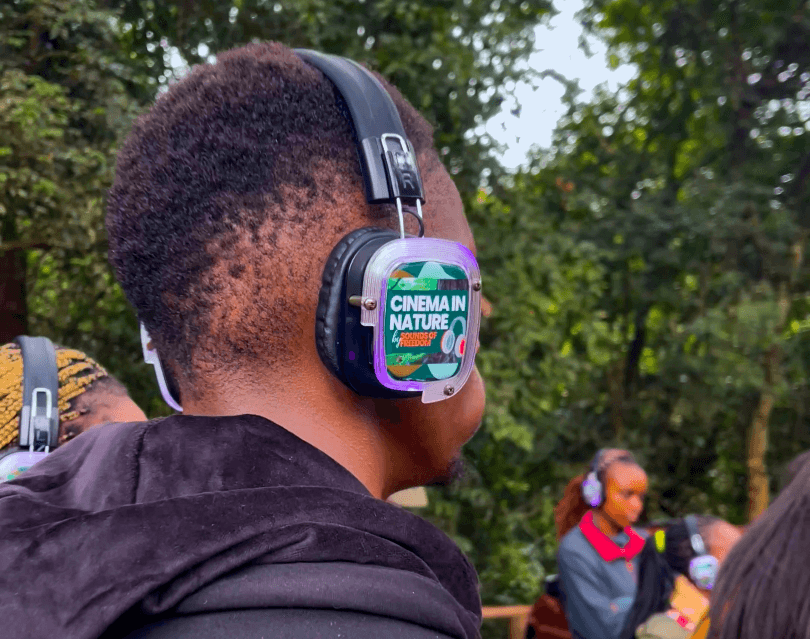A group of young people gathered at the entrance of Karura Forest, headphones in hand, ready for a unique history lesson. As they wandered beneath the forest's thick canopy, they listened to the sounds of birds and leaves mixed with immersive audio storytelling about Kenya's struggle for independence. Mutana Wanjira, founder of the Sounds of Freedom nonprofit organisation, created the Cinema in Nature audio film initiative. It brings the stories of Kenya’s Mau Mau independence fighters to life in the exact area where many once sought refuge.

Velma Pamela, Bird Story Agency
Mutana Wanjira, founder of the Sounds of Freedom nonprofit organisation based in Nairobi, created the Cinema in Nature project, which brought the stories of Mau Mau combatants to life in the exact area where many once sought refuge.
Karura Forest, located on the northern border of Nairobi, Kenya's capital, covers more than 1,000 hectares (10 square kilometres), making it one of Africa's largest urban forests. Located approximately 5 kilometres from the city centre, it provides a green respite from Nairobi's fast-paced daily life.
It was once preserved by Nobel laureate Wangari Maathai, but today it serves as a living archive of memory and a vibrant stage for initiatives such as Sounds of Freedom’s Cinema in Nature.
Mutana, a filmmaker and cultural innovator, is the driving force behind Cinema in Nature, an immersive storytelling initiative that explores Kenya's independence movement through nature, art and audio films. Launched in October 2021 to commemorate Mashujaa (Heroes) Day, the first episode of the audio film was released as a tribute to Kenya’s independence heroes, with its premiere held at Alliance Française in Nairobi.
Cinema in Nature invited audiences to enter the forest, put on headphones, and walk along curated trails while listening to a dramatised audio story of Kenya's Mau Mau resistance in the same forests and caves where these events took place.
"By walking through the forest and listening to these stories, people experience history in motion; they walk in the footsteps of their ancestors, have fun, get creative, paint, picnic, and just have different perspectives on what freedom means to them," said Mutana in an interview.
Karura Forest, formerly a battleground for land and identity, is now a living classroom.
During Kenya's struggle for independence, forests like Karura provided crucial refuge for Mau Mau fighters. These dense and expansive natural landscapes provided shelter from British colonial forces, allowing freedom fighters to plan, train, and carry out guerrilla actions.
The forest's dense cover and familiarity with local warriors gave them a strategic advantage, allowing them to avoid arrest and form bonds among their ranks. Walking through Karura today is more than just a return to nature; it's also a silent reminder of the bravery that once thrived beneath its trees.
The first episode of the Sounds of Freedom audio film project follows two young recruits who, after joining the war for independence, get lost in the forest while looking for Dedan Kimathi and attempting to enter the Kenya Land and Freedom Army, also known as the Mau Mau.
According to the National Museums of Kenya, approximately 11,000 Mau Mau warriors died during the fight for independence, with thousands more imprisoned in colonial facilities. In recent years, attempts to preserve this history have increased. As of 2023, the Kenyan government has spent more than KSh 500 million on the documentation and commemoration of independence fighters across the country.
The project is based on a significant narrative shift: from history as something read in textbooks to heritage as something lived, heard, experienced and co-created.
Episode Two, launched on May 31st, 2025, dug deeper into high-stakes missions inspired by genuine events from the colonial resistance. It combined story and action, giving characters a cinematic role in history.
“An audio film is more than just a film that doesn't have visuals,” Mutana Wanjira explained. The reason why the audio film is important to us is because we want you to be in this very forest, and we also want you to connect with the actual nature that you're in, you know, to feel the different sounds in your headphones as well as in the environment, and this is what becomes the totality of our immersive audio film."
While they walked listening to the audio stories, they visited sites within the forest such as caves where Mau Mau fighters hid as they carried out ambushes against British colonial forces, who struck back with air raids, bombing these hideouts.
Mutana’s audio film has added written content with facts and data regarding Kenya's struggle for independence that visitors can read as they walk around the area, as well as images and poetry that connect the physical environment we live in today to the stories and significance this space has held for previous generations.
According to a 2023 UNESCO review, 68% of African youth claim they don't have significant access to their country's cultural history in ways that are relatable. With young Kenyans eager to reconnect with their country's history, Cinema in Nature seeks to bridge that gap by providing a modern yet deeply rooted medium for young Kenyans to explore and embrace their heritage.
“It’s not just about nostalgia. It’s not just about looking back at history as something old or distant. It’s about discovering your heritage and thinking about what you can do in your country, how these real stories can inspire you to move the needle in your way,” said Mutana.
The Cinema in Nature model emphasises agency rather than merely education. In a country where 75% of the population is under the age of 35 (KNBS, 2023), involving young people is not only strategic but also necessary.
Participants of the experience, many of them in their 20s and 30s, often leave transformed, describing the events as “mind-opening”, “emotionally grounding” and “deeply Kenyan”.
Yvonne, 25, a participant, found the post-painting session to be a refreshing and introspective opportunity to interact creatively with history.
“Culture and history shape identity,” Yvonne said. “Preserving stories through recordings is effective because it’s easy to access and share across generations.”
She added that hearing the stories in the actual place where they happened made the experience “more profound” and helped deepen her connection to Kenya’s past.
The Sounds of Freedom initiative has already collaborated with schools, corporate teams, and youth organisations to transform the experience into formats that promote learning, teamwork and leadership development.
Kenya's Cinema in Nature is not alone in its efforts to reinvent how history is remembered and communicated. It is part of a rising movement in Africa that is changing the way history is transmitted by combining narrative, technology, and nature to engage young people. From Nigeria's John Randle Centre to Ghana's Legacy Through Pixels, new projects are transforming legacy into immersive, interactive experiences that demonstrate how the past can be lived rather than merely remembered.
As part of this continental change, immersive audio storytelling stands out for its capacity to spark imagination.
Voice actor and director Martin Kigondu notes that it “encourages unbounded imagination as the audience creates the visual aspects for themselves.” He adds that these new forms “awaken us to ourselves” and inspire bold, creative responses to present challenges. Producing such experiences, he says, requires “great imagination, audacity, and willingness to think outside the box” and strong partnerships to help broaden what's possible.
Building on its success in Kenya, Cinema in Nature made its worldwide premiere in London on May 31, 2025. The immersive audio walk took place in Richmond Park, transforming one of the city's most beautiful natural spaces into a setting for Kenya's independence story.
Mutana’s long-term goal is to decentralise historical narration, moving beyond museums and archives into locations where people may feel free and inspired.
“Cinema in Nature is just bringing someone much closer to nature, much closer to the environment. And this is what becomes the totality of our immersive audio film.”
As climate change, digital transformation, and cultural globalisation alter the fabric of African societies, initiatives like Cinema in Nature help restore a sense of place, history, and identity. Mutana sees the experience as more than just entertainment — to him, it's a form of cultural healing and remembrance.
Bird Story Agency





